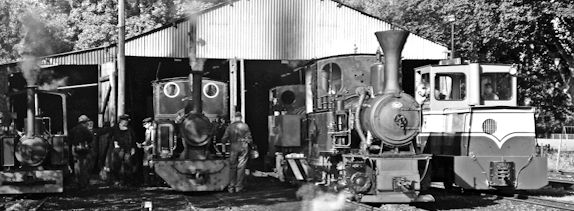
Britain’s last substantial 2 ft gauge industrial railway
Stonehenge Works, Mile Tree Road, Leighton Buzzard, Bedfordshire
The Leighton Buzzard Light Railway (LBLR) is a 4.8 km (3 miles) long narrow gauge light railway in Leighton Buzzard in Bedfordshire, operating on a 2 ft (610 mm) gauge. When the outbreak of the First World War cut off supplies of foundry sand from Belgium, more local sources were sought to supply ammunition factories and Leighton Buzzard sands proved to be suitable. In 1919, with quarry companies no longer able to transport sand by roads, a private industrial railway was proposed, opening on 20 November of that year.
The LBLR linked the Double Arches sand quarries with the mainline, south of the town at Grovebury sidings, utilising ex-War Department Light Railways surplus equipment. Steam traction was provided by two Hudswell Clarke 0-6-0 side tank steam locomotives, but these proved inappropriate for the tightly-curved line and were sold off in 1921. Subsequently, the railway was run using internal combustion (almost exclusively Motor Rail Company products), becoming one of the first railways in Britain entirely operated by internal combustion.
Following the Second World War, sand traffic returned to the roads; in 1953, a mainline railways strike pushed even more traffic onto the roads and, by the mid-1960, s only one sand quarry - Arnold's - still used the light railway. The BR line to Dunstable was closed in 1965, apart from a short stretch from Leighton Buzzard to Grovebury interchange sidings, which survived until 1969.
In 1968, volunteers took over the line on weekends to run the first formal passenger services on the line, operating as "The Iron Horse Railway Preservation Society". The agreement required the volunteers to repair the permanent way. The Society also purchased secondhand rolling stock and four Simplex diesels from the St Albans Sand & Gravel Company, the latter dismantled to form one viable diesel locomotive. The last sand train ran on the British main line in 1969, with the last internal quarry line abandoned in 1981, conveyor belts and roads having taken over from locomotive haulage.
Today the line is run as a heritage railway, with a large collection of steam and internal combustion locomotives. The line is unusual as it runs mostly through modern housing built since the 1970s, although the last 0.8 kms (0.5 miles) runs through countryside. There are open level crossings for which trains stop.
The last four images are (c) Wizardly Images - with thanks.
By road: Off A4146
By rail: Leighton Buzzard Station is c. 4 kms away

Aves, William, The Railway Operating Division on the Western Front: The Royal Engineers in France and Belgium 1915-1919, Shaun Tyas, ISBN-10: 1900289997 (2009)
Bryan, Tim, Railways in Wartime, Shire Publications, ISBN-10: 0747810508 (2011)
Dingwall, Rod, Narrow Gauge Tracks in the Sand: Leighton Buzzard Light Railway, The Oakwood Press, ISBN-10: 085361508X (1997)
Leleux, Sydney, Leighton Buzzard Light Railway, The Oakwood Press, ISBN-10: 0853614601 (1996)
Light Railway Commissioners, Light Railways Act, 1896.. Order Made By The Light Railway Commissioners...Authorising The Construction Of A Light Railway In The Counties Of Bedford And Of Hertford From Leighton Buzzard To Hitchin, Houses of Parliament, ASIN: B0013IOLX0 (1904)
Squires, Stewart, The Lincolnshire Potato Railways, The Oakwood Press, ISBN-10: 0853616469 (2005)
Whitehouse, Patrick & Snell, John B., Narrow Gauge Railways of the British Isles, David & Charles, ISBN-10: 0715385232 (1984)